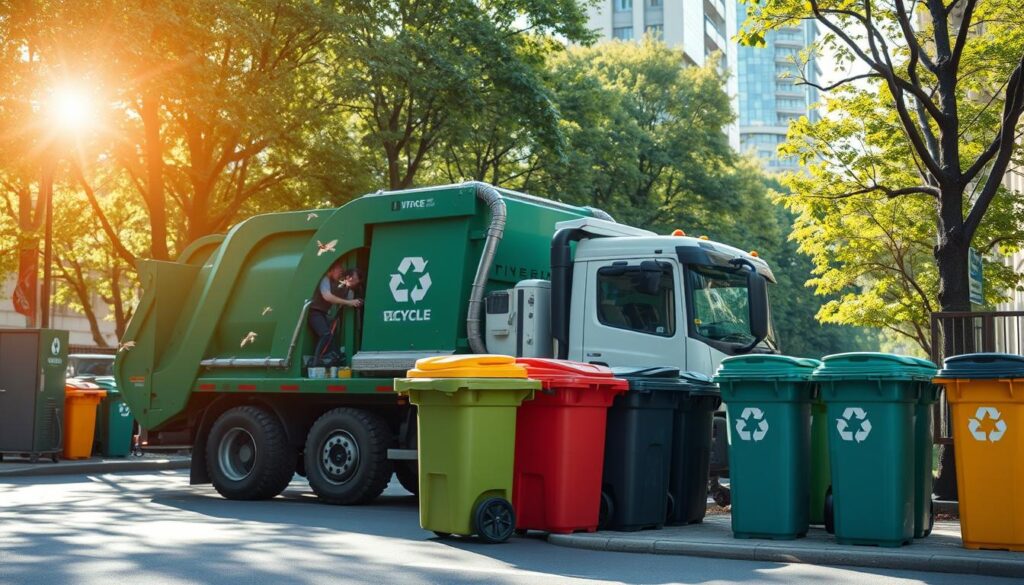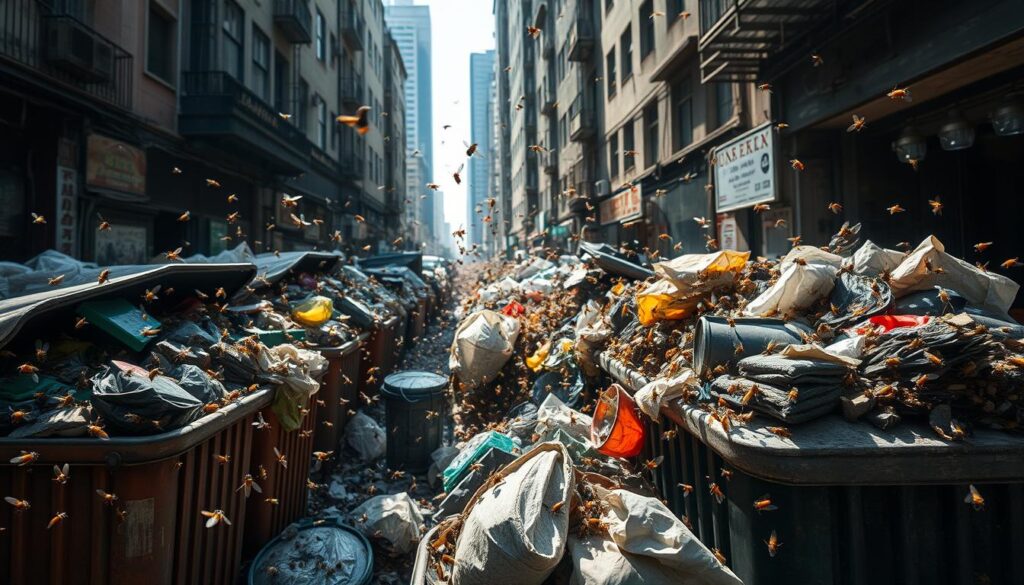Ever thought about how often waste is collected and flies in your area? A cool study by the London School of Hygiene and Tropical Medicine found something interesting. They looked at a slum in Islamabad, Pakistan, and found a big difference.
Houses with regular waste collection had five times fewer flies than those without. But does this always happen? Or are there other things that matter too? Let’s find out more about how waste management affects flies.
Key Takeaways
- Homes with regular rubbish collection have significantly fewer flies than those without consistent waste pick-up.
- Uncollected plastic waste can lead to between 400,000 and one million deaths annually due to associated health risks.
- Globally, only one in four individuals have their rubbish collected, with the lowest rates in Africa (25%-70%) and Asia (50%-90%).
- Improved waste collection services can lead to a substantial decrease in fly populations, as seen in the Islamabad study.
- Socio-economic factors and community engagement play a crucial role in the success of waste collection initiatives.
Introduction
Solid waste comes from homes, farms, factories, and schools. If we don’t manage it well, it can harm our health. As places grow and get richer, so does the waste.
Badly managed solid waste disposal leads to sickness and pollution. It costs us money and health. Pests like mosquitoes and rats in waste spread diseases.
The Threat of Disease Vectors
Bad waste disposal practices let pests like mosquitoes and rats grow. They carry diseases like malaria and dengue. This is a big public health threat, especially in urban low-income communities.
“Mismanaged solid waste is likely to be an important factor underlying the global burden of disease.”
Burning waste also harms our lungs and hearts. It can cause lung cancer and heart disease. Waste leachate pollutes our environment with harmful chemicals.
We need to tackle municipal waste management and reduce waste. This is key to keeping our health and environment safe in all communities.
Waste Collection Frequency
Collecting waste well is key for public health and stopping diseases like flies. But, a lot of waste is not picked up, especially in Africa and Asia. Here, collection rates can be very low, from 25-70%. Better waste services can help the environment and stop diseases.
How often waste is collected affects recycling. Studies from the UK and elsewhere show that less waste collection can help. This makes people more likely to recycle.
- On average, 40% of household rubbish is food waste.
- In Wales and Scotland, limiting waste collections and having weekly food waste helps a lot. It encourages recycling and cuts down on waste that can’t be recycled.
- More councils in England, Scotland, and Wales are now collecting waste every three weeks. This has led to better recycling and less waste.
By changing how often waste is collected, councils can do better. They can recycle more, send less waste to landfills, save money, and cut carbon emissions. This fits with the UK’s goal to recycle 65% of waste by 2035.
“Evidence, particularly from Wales, shows that three- or four-weekly residual waste collections deliver better recycling rates, result in less residual waste being generated, and help save money and carbon emissions.”
Councils are looking at new ways to manage waste. The timing of garbage collection is very important. It will help the UK reach its recycling goals.
Study in Pakistan: Methodology
The study was done in six low-income areas in Islamabad, Pakistan. It looked at how a waste management plan changed how people threw away waste and fly numbers. Four areas got a door-to-door waste pickup with recycling, and two were controls.
Study Design and Population
The study used a cross-sectional survey. It collected data at the start and later in 180 homes per area. This helped see how the waste plan changed waste disposal, exposure to waste, and fly numbers.
At the study’s start, the intervention areas had worse socio-economic status and less waste service access. This showed the waste service could greatly help these poor urban areas.
| Indicator | Intervention Communities | Control Communities |
|---|---|---|
| Waste Collection Service Uptake | 5% to 49% increase | 21% to 67% increase |
| Fly Counts | 60% decrease | Remained the same |
This study’s findings are very useful. They show the good of low-cost waste services in poor urban areas. But, they also point out the challenges of getting everyone to use the service.
Intervention and Implementation
This study had a plan to fix the problem of bad waste disposal. It had three main parts:
- Community mobilisation through activities at home and in the community. This taught people why proper waste disposal is key for a clean and healthy place.
- A subscription-based, door-to-door waste collection service by paid staff. This made sure waste was taken away regularly, stopping it from building up.
- The setting up of recycling sites for sorting waste. This helped turn organic waste into compost and non-organic into recyclables. It aimed to reduce waste going to landfills.
Local waste dealers were involved to keep their income steady. The project was tested in two groups to see how it worked and make changes before it grew.
This plan mixed community work, reliable waste pick-up, and green recycling. It aimed to tackle waste management’s many problems and bring in community mobilisation, door-to-door waste collection, centralised waste processing, and revenue generation from selling recyclables.
“The intervention aimed to create a sustainable waste management system that would improve public health and the environment while also generating revenue for the community.”

Results and Findings
Waste Collection Service Uptake
The study found interesting facts about waste collection service use. At the start, some areas had less money and worse waste services than others. But, the new program made a big change.
It made more people use waste collection services. In some areas, over 80% and 90% of people started using it. This was a big jump from before.
Even the areas without the program saw more people using waste services. They went from 21% to 67%. This shows that many factors affect how we handle waste.
| Metric | Intervention Communities | Control Communities |
|---|---|---|
| Baseline Waste Collection Use | 5% | 21% |
| Post-Intervention Waste Collection Use | 49% | 67% |
| Percentage Point Increase | 44% | 47% |
The study shows the new program really helped. It made a big difference in some places. But, it also shows that money and access matter too.
Impact on Fly Populations
A study in Pakistan showed how important waste collection is. It found that regular rubbish collection cuts down fly numbers a lot. Houses with waste collection had five times fewer flies than those without.
The study saw a big drop in fly numbers where waste collection was introduced. Fly counts fell by about 60% in these areas. But, in areas without waste collection, fly numbers stayed the same.
But, the biggest drop in fly numbers was where waste collection was very good. Over 80% of waste was collected in these places. This shows how key it is to get many people to use waste collection services.
| Indicator | Intervention Communities | Control Communities |
|---|---|---|
| Increase in Waste Collection Service Use | 44% (95% CI 41%, 48%) | 47% (95% CI 41%, 53%) |
| Decrease in Fly Counts | 60% (rate ratio 0.4, 95% CI 0.3, 0.4) | No decrease (rate ratio 1.52, 95% CI 1.1, 2.2) |
Introducing a low-cost waste collection service can really help. It can cut down on disease vectors like synanthropic flies in poor urban areas. But, it needs a lot of people to use it well.

Challenges and Limitations
The study showed that not all communities joined the waste collection program. This was because some communities had less money and worse access to services. To make waste collection work for everyone, we need to get more people involved and find ways to pay for it.
Income and job rates matter a lot for waste collection. Places with less money and more joblessness saw fewer people join. We must think about each community’s needs to help more people.
- Socio-economic disparities impacted the community engagement and the overall service coverage of the waste collection intervention.
- Developing a sustainable financing model for waste collection services was identified as a key challenge, particularly in lower-income communities.
- The study highlighted the importance of understanding and addressing intervention constraints specific to each community to ensure the long-term success of such programmes.
“Achieving high levels of community buy-in and developing a sustainable financing model for waste collection services are key challenges that need to be addressed to ensure the long-term success of such interventions.”
We need a plan that involves the whole community for waste management. By looking at money and jobs, we can get more people to help. This way, we can make waste collection better and last longer.
Conclusion
This study shows how important waste management is for keeping people healthy and safe from harm. By having a good waste collection service, you can cut down on flies. Flies can spread diseases and harm people’s health.
To make waste management work, it’s key to get everyone involved and change their habits. We need to overcome obstacles that stop people from using waste services. Creating new ways to pay for services and working with local groups can help make waste management better.
Keeping waste collection regular is vital to fight flies and protect health and the environment. Making waste management a big part of your community plan can make cities cleaner and healthier. This benefits everyone living there.
